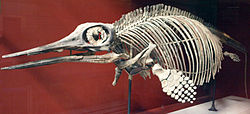Ophthalmosauridae
| Ophthalmosaurids | |
|---|---|

| |
| Ophthalmosaurus icenicus skeleton at Natural History Museum, London | |
| Scientific classification | |
| Domain: | Eukaryota |
| Kingdom: | Animalia |
| Phylum: | Chordata |
| Class: | Reptilia |
| Order: | †Ichthyosauria |
| Clade: | † Baracromia
|
| Family: | †Ophthalmosauridae Baur, 1887 |
| Subgroups | |
| |
| Synonyms | |
| |
Ophthalmosauridae is an extinct family of
Phylogeny

Ophthalmosauridae is a
| Thunnosauria |
| ||||||||||||||||||||||||||||||||||||||||||||||||||||||||||||||||||||||||
Valentin Fischer, Edwige Masure, Maxim S. Arkhangelsky and
| Thunnosauria |
| |||||||||||||||||||||||||||||||||||||||||||||||||||||||||
*Note: Placement of Ophthalmosauria by definition.
Fischer et al. (2012) described another new genus of Ophthalmosauridae. They defined for the first time two
| Thunnosauria |
| ||||||||||||||||||||||||||||||||||||||||||||||||||||||||||||||||||||||||
Since 2019
In 2019, two species of Cryopterygius were assigned to the genus Undorosaurus by Zverkov & Efimov (2019). The authors considered the type species of the former genus, C. kristiansenae, to be synonymous with Undorosaurus gorodischensis; second species of Cryopterygius, C. kielanae, was tentatively maintained by the authors as a distinct species within the genus Undorosaurus.[10]
The following cladogram shows a possible phylogenetic positions within Ophthalmosauridae according to the analysis performed by Zverkov and Jacobs (2020).[11]
| Ophthalmosauria |
| ||||||||||||||||||||||||||||||||||||||||||||||||||||||||||||||||||||||||||||||||||||||||||||||||||||||||||||||||||||||||||||||||||||||||||||||||
References
- ^ S2CID 86036325.
- ^ PMID 33665003.
- S2CID 130751356.
- ^ doi:10.1080/02724634.1999.10011160. Archived from the original(PDF) on 2016-03-05. Retrieved 2011-10-19.
- ^ ]
- S2CID 91912834.
- S2CID 244512087.
- ^ a b c d Arkhangel'sky, M. S., 1998, On the Ichthyosaurian Genus Platypterygius: Palaeontological Journal, v. 32, n. 6, p. 611-615.
- PMID 22235274.
- S2CID 91912834.
- .
